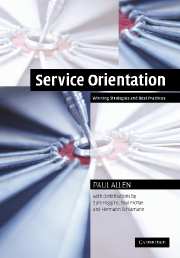Book contents
- Frontmatter
- Contents
- Foreword
- Preface
- Acknowledgments
- List of acronyms and abbreviations
- PART 1 OVERVIEW
- PART 2 BUSINESS ARCHITECTURE
- 4 Service-oriented process redesign
- 5 Gleaning business value
- 6 Achieving business agility
- PART 3 SERVICE-ORIENTED ARCHITECTURE
- PART 4 SERVICE-ORIENTED MANAGEMENT
- PART 5 CASE STUDIES
- References
- Useful sources of information
- Index
6 - Achieving business agility
from PART 2 - BUSINESS ARCHITECTURE
Published online by Cambridge University Press: 31 July 2009
- Frontmatter
- Contents
- Foreword
- Preface
- Acknowledgments
- List of acronyms and abbreviations
- PART 1 OVERVIEW
- PART 2 BUSINESS ARCHITECTURE
- 4 Service-oriented process redesign
- 5 Gleaning business value
- 6 Achieving business agility
- PART 3 SERVICE-ORIENTED ARCHITECTURE
- PART 4 SERVICE-ORIENTED MANAGEMENT
- PART 5 CASE STUDIES
- References
- Useful sources of information
- Index
Summary
Introduction
We now turn toward scaling up the early efforts at business process redesign. In chapter 5, we sketched out some tactical scenarios that illustrated the use of existing assets to start to redesign existing processes. Web services were used in opportunistic fashion to leverage some of these assets through wrapping. The Web services were little more than single operations applied to very specific business requirements.
In this chapter, we move to the longer-term, strategic view to identifying and designing services that can meet the wider SOV7 requirements. This will involve considering the aspects of the BA shown in figure 6.1. We will move from left to right across this picture, starting with the service policy aspects, then considering domain models, and finally considering the two service models on the right-hand side. In particular, we focus on exploring how services can be used in different business contexts. These considerations in turn will cause the processes to be re-evaluated and developed so that they become more service-oriented.
A major part of this work concerns surveying and cataloging of corporate assets, of which services are a part. At the end of this chapter, we therefore also consider the place of the asset inventory in relation to this work.
Service policy
Service policy covers business goals and rules, the business–IT alignment table (BIAT), and sourcing and usage policy: the four items shown on the left of figure 6.1.
- Type
- Chapter
- Information
- Service OrientationWinning Strategies and Best Practices, pp. 103 - 122Publisher: Cambridge University PressPrint publication year: 2006

